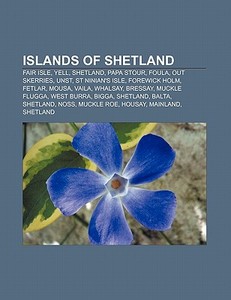
Islands of Shetland
Fair Isle, Yell, Shetland, Papa Stour, Foula, Out Skerries, Unst, St Ninian's Isle, Forewick Holm, Fetlar, Mousa, Vaila, Whalsay, Bressay, Muckle Flug
- Editore:
Books LLC, Reference Series
- EAN:
9781156096895
- ISBN:
1156096898
- Pagine:
- 40
- Formato:
- Paperback
- Lingua:
- Inglese
Descrizione Islands of Shetland
Source: Wikipedia. Pages: 40. Chapters: Fair Isle, Yell, Shetland, Papa Stour, Foula, Out Skerries, Unst, St Ninian's Isle, Forewick Holm, Fetlar, Mousa, Vaila, Whalsay, Bressay, Muckle Flugga, West Burra, Bigga, Shetland, Balta, Shetland, Noss, Muckle Roe, Housay, Mainland, Shetland, Trondra, Linga, Yell, West Linga, Uyea, Unst, Hildasay, Samphrey, South Havra, Broch of West Burrafirth, Vementry, Bruray, Brother Isle, Bound Skerry, Hascosay, East Burra, East Linga, Uyea, Northmavine, Linga, Muckle Roe, Out Stack, Huney, Papa Little, Lamba, Holm of Noss, Oxna, Papa, Shetland, Grunay, Linga, Samphrey, Little Roe, Scalloway Islands, Dore Holm, Cheynies, Gloup Holm, Grif Skerry, Uynarey, Urie Lingey, Gruney, Horse Holm, Colsay, Sound Gruney, Langa, Shetland, Isle of Stenness, Orfasay, Lunna Holm, Brough Holm, Fish Holm, Little Holm, Scatness, Burwick Holm. Excerpt: Yell is one of the North Isles of Shetland, Scotland. In the 2001 census it had a usually resident population of 957. It is the second largest island in Shetland after the Mainland with an area of 82 square miles (212 km), and is the third most populous in the archipelago (fifteenth out of the islands in Scotland), after the Mainland and Whalsay. The island's bedrock is largely composed of Moine schist with a north-south grain, which was uplifted during the Caledonian mountain building period. Peat covers two thirds of the island to an average depth of 1.5 metres (5 feet). Yell has been inhabited since the Neolithic times, and a dozen broch sites have been identified from the pre-Norse period. Norse rule lasted from the 9th to 14th centuries until Scottish control was asserted. The modern economy of the island is based on crofting, fishing, transport and tourism. The island claims to be the "Otter Capital of Britain" and has a diverse bird life including breeding populations of Great and Arctic Skuas. Notable buildings on the island include the 17th century Old Haa of Brough in Burravoe , a merchant's house now converted to a museum and visitor centre. There are various folk tales and modern literary references to island life. Yell is 19 miles (31 kilometres) in length, with a maximum breadth of 7.5 miles (12 kilometres), and is swept all around by very impetuous tides. The island extends northward to within 9.5 miles (15 kilometres) of the northwestern extremity of Unst. It is divided by only the narrow Bluemull Sound from the south west of Unst. On the eastern side the coast is generally low and sandy but there is an extensive rocky and partly precipitous coast on the west that rises slowly to elevations of 200-400 ft (60-120 metres). It is indented by seven or eight bays forming natural harbours. As Penrith's guide to Orkney and Shetland states - "The island is roughly rectangular and nearly cut in two where the long voes of Whale Firth and Mid Yell almost meet."

